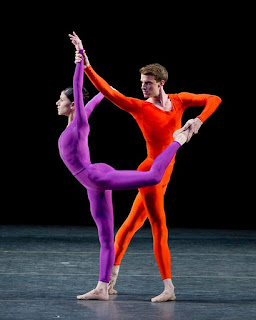Jean Paul Gaultier has always had an open-minded view of society; exploring and investigating ideas with a grand sense of humor.
Gaultier started his career in 1970 at age 18 as an assistant to Pierre Cardin, and more recently he has been the creative director of Hermès from 2003 to 2010. Gaultier is known for using unconventional models for his exhibitions like full-figured, older women, and tattooed models as well as conventional models. This is partly why he’s so recognizable and popular as a designer. He has said, “In life, I like the blemishes, scars, emotions of the skin, of the flesh, of movement—everything that is human.” I think he has a special eye to view the beauty of life. He has also said, “Women become beautiful once they become forty.”
Walking slowly through the Dallas Museum of Art I could hear the soundtrack of Gaultier’s life playing through his six themed rooms: “The Odyssey of Jean Paul Gaultier,” “Boudoir,” “Skindeep,” “Punk Cancan,” “Urban Jungle,” and “Metropolis.” These six rooms feature approximately 130 ensembles from his couture collections.
I imagine his playlist might include some Boy George, Carla Bruni-Sarkozy, Madonna, Kylie Minogue, Amy Winehouse, the soundtrack to Nine and some Cole Porter Anything Goes.
Porter’s lyrics to Anything Goes couldn’t be more parfait for Gaultier!
In olden days a glimpse of stocking
Was looked on as something shocking,
But now, God knows,
Anything Goes.
Entering the energetic atmosphere there are thirty life-like mannequins to great you in first room “The Odyssey of Jean Paul Gaultier” including a mannequin of the “bad boy sailor” Gaultier himself speaking, “Hello, welcome, I am Jean Paul Gaultier. I am very happy to receive you here in the Dallas Museum of Art. Enjoy the show.
It is such a pleasant treat that more and more museums are welcoming fashion. Dallas has been in the lime light twice now. It was just a few years ago that SMU welcomed Spanish designer Balenciaga. In 2008, New York City’s Metropolitan Museum of Art hosted the Chanel exhibition and more recently the MET also featured Alexander McQueen’s designs.
Although Gaultier says he doesn’t think about a certain time period for his inspiration, he can make you feel like you just stepped back in time or into the future like he did in The Fifth Element movie.
Museum visitors feels like they could be in the Belle Époque period about to run into Toulouse Lautrec painting Jane Avril doing the cancan. Then he takes the audience to Amsterdam’s red light district in the “Boudoir” room. A cigarette seemed an appropriate thing to have after being in the “Boudoir” and “Skindeep” rooms… et voila, many of the mannequins were holding cigarettes in the next room smoking for the audience on a moving runway oval platform. It’s as if he wanted us to feel the experience and I can just imagine him saying in his French accent, you just had some naughty fun in Amsterdam and now I’m bringing you the 80s London punk scene and then onward to the "Urban Jungle."
My Ukrainian friend found herself drawn to a dress that was a Tribute to Ukraine. The stunning dress took 242 hours to create.
After seeing The Fashion World of Jean Paul Gaultier: From the Sidewalk to the Catwalk it is certain that Gaultier speaks to all kinds of women. His attitude is that fashion is for everyone. He is playful, whimsical, provocative and imaginative.
What I love about Jean Paul Gaultier is that, like a Picasso, he is easily distinguishable . His style is unapologetic, has good humor, and combines couture with culture.
His artsy, chic, and fashion forward grandmère was his first muse. He played in her closet and was fascinated with the discovery of the corset and wearing underwear as outerwear. He would watch his eclectic grandmother sip vinegar to make herself gasp and contract her stomach muscles and then cinch her corset tighter.
He has been inspired by the streets of London punk music scene, Paris, Folies Beregere, but it was the 40s movie Falbalas that made him want to become a designer. Old movies and showgirls also evoked his passion for fashion.
My mom sent me his first corset bottle perfume when I was in college in 1993 at the University of Alabama. My sorority sisters in the Bible belt couldn’t believe I had such a naughty bottle in my room. The bottle oozed sex! That’s what I mean about Gaultier being unapologetic; his style is “in your face” unique with a side of sex.
He’s had many a famous muse throughout his career: Catherine Deneuve, Helen Mirren, Carla Bruni-Sarkozy, Madonna, Charlotte Rampling…to name a few.
Madonna’s costumes for the 1990 “Blond Ambition" tour was one of the highlights of the exhibition.
Gaultier has always had a thing for sailor stripes; the stripes portray his bad boy “enfant terrible” image perfectly. A name he earned in the 70s for his first fashion show because of his tendency in challenging the then common views of fashion by reworking them exhaling into them the breath of his own ideas.
He’s inspired by movement and does a lot of design for ballet. Most recently he designed costumes for Angelin Preljocaj’s Snow White ballet and his motivation from the movie The Black Swan can be identified in his pieces in the Fall 2011 couture collection.
Dallas has much to be proud of and we have been extremely lucky to debut Gaultier’s show as one of only two U.S. A. stops. After the show ends in Dallas (February 12th), it will travel to San Francisco.
Jean Paul Gaultier has definitely made his mark on what fashion is today. The Dallas Museum of Art honors him with a tribute to life. C'est Magnifique!


















